Submersible well pump features selection
At arrangement of autonomous water supply on the basis of a well, an important point is the organization of delivery of water for which the pump is responsible. Therefore, before the owners of the plots, the question of choice arises acutely, for example, you can use a screw submersible pump for a well, a centrifugal machine or some other type of apparatus. All of them differ in power, maximum allowable depth and many other characteristics.

To help in this matter, we will consider the most common types of pumps, their features, as well as the rules for choosing a device.
General information
The main difference between a submersible pump and a surface pump is that the submersible is located below the water level that cools the device. If the water level falls below the pump, it turns off (cheap models do not have automatics and therefore fail to work in air).
Why use a submersible water pump for a well if you can use a surface one, the cost of which is much lower? This is due to the fact that surface pumps are less powerful and if the depth of the well is more than 10 meters, then there is simply no choice.

I must say that it is possible to use both special pumps for the well and devices for wells, however, the price for the latter is somewhat higher. They are arranged in the same way and the differences are only in form. This is due to the fact that the well has a small diameter, respectively, the device is made elongated, cylindrical.
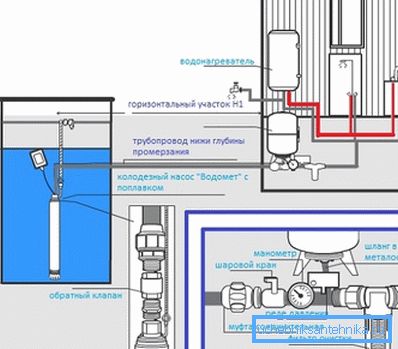
For a well, such a form is, rather, a disadvantage, since according to the existing rule, the water level at the bottom and top of the pump must be at least one meter. Accordingly, if the well is not deep, then observe it, having placed the pump in a vertical position, will not work. But, despite this, the owners of wells often use just such devices.
Types of pumps
Most often in wells pumps of the following types are used:
- Multistage (centrifugal);
- Screw or, as they are called, screw;
- Vibration.
Now consider the features of each species.
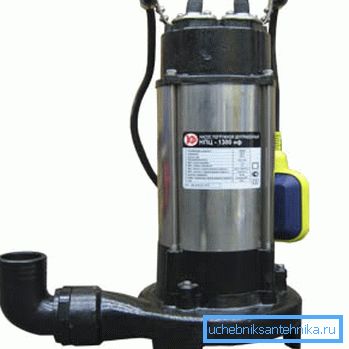
Centrifugal pumps
The purpose of this type of equipment is the rise of drinking water from a great depth. Centrifugal pumps are characterized by high performance and reliability. In addition, the maximum allowable amount of sand impurity is 180 grams per cubic meter, which is a very large figure for a submersible pump.
With the help of them it is possible to provide a good pressure of the water extracted from a depth of up to 120 meters. Therefore, they are used not only in wells, but also artesian wells. In addition, another advantage of such devices is that they are able to work without interruption for a long time.
As for structural features, inside the device there is an impeller with blades fixed on it. The electric motor sets this wheel in motion, with the result that in the middle of the impeller a reduced pressure is formed, and in the region of the blades - increased pressure. Due to this pressure difference, water is first sucked into the center of the wheel, and then pushed into the pipeline.
As a rule, such pumps are provided with thermal protection, which turns off the device in case of emergency situations. In addition, they are equipped with floats and electronics for protection against working in the air.
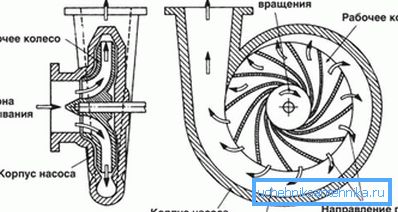
The case of the centrifugal pump can be made of stainless steel or plastic. As a rule, plastic cases are supplied by cheaper models, which cost about $ 100. The price of expensive models can reach 700 US dollars.
The Italian submersible pumps for ZDS and Pedrollo wells have proven themselves well, in addition, Denmark (Grundfos), Germany (Wilo), Russia (Water cannon) produces good devices of this type. However, it should be borne in mind that the same manufacturer can produce both cheap and expensive models, the quality of which will be very different.
Vibratory pumps
The main difference between vibration pumps and devices of another type is that they have no rotating parts. Inside the case there is a core with a winding on which electricity is supplied. As a result, an electromagnetic field is formed, as a result of which a rod with a piston at the end is attracted to the core.

At this point, water is drawn in, but after a fraction of a second the electromagnetic field disappears, and the piston returns to its original position, the check valve closes and the water is pushed into the chamber. When the piston and rod are again attracted to the core, water is pushed into the pipeline.
Such equipment is not recommended to be installed close to the bottom of the well, because as a result of vibration, small particles of sand may rise from the bottom. This will cause the water filter to fail quickly.
Note! It is not recommended to install the vibrating submersible pump in the well, which is arranged on the quicksand, as the equipment can negatively affect the fragile soil.
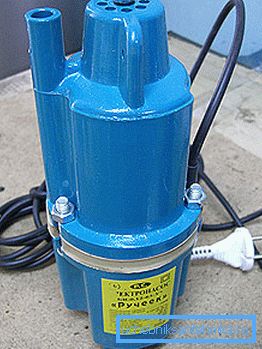
Vibrating pumps are a cheap category of equipment, so they are often used by summer residents.
The most common are models of domestic production:
- "Brook";
- "Kid";
- "Summer resident";
- "Aquarius".
The average cost of such devices is about $ 50. In addition to the low price, another advantage is their reliability, since the design does not contain parts that can overheat. However, for a house in which the family lives permanently, the best choice is, nevertheless, a centrifugal pump.
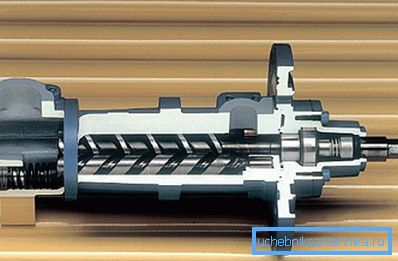
Screw pumps
The main feature of this pump is that it can pump over contaminated water, so it can be used not only for the well, but also, for example, for a reservoir with technical water to supply it with an irrigation system. In addition, these pumps can work with different types of liquids, so they are actively used in the chemical industry, housing and utilities, etc.
Screw submersible pumps for wells also have a very high wear resistance and reliability due to a simple mechanism, which is based on a worm screw. Rotating, the screw creates a cavity, which is filled with water and moves to the pipeline. To make it easier to understand this principle, imagine an ordinary meat grinder, in which a screw provides movement of pieces of food to the knives.
The only disadvantage of this pump is that it cannot extract water from a great depth. Therefore, if the well is deeper than 15 meters, you will have to pay attention to other types of devices.
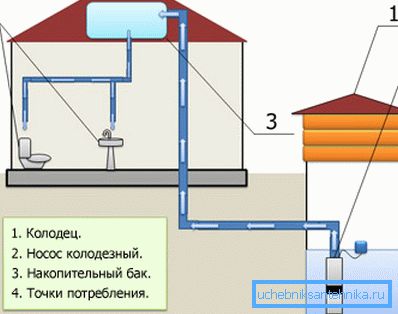
How to choose a pump for a well
So, with the main types of pumps that can be used in wells, we figured out. Now consider how to choose a pump so that it can smoothly provide the house with the necessary amount of water.
To do this, you need to decide on the requirements for the device, including:
- The performance of the device - the amount of water that the pump is able to submit for a certain time. As a rule, this value is indicated in cubic meters (or liters) per hour.
- The water pressure that the device can provide.
- The maximum depth at which the device should work.
- Ability to work with sandy impurities.
Performance
First of all, you need to decide what kind of pump performance will be needed in your case.
Instructions for counting performance is as follows:
- First you need to count the number of mixers and taps to be used in the house, after which the resulting number should be multiplied by 500 liters per hour.
- If you plan to use the irrigation system at the site, then you need to add another 500 liters per hour.
- Then, to the obtained value, it is necessary to add another 10 -15 percent of the safety margin so that the pump does not work at the limit of its capabilities, which will extend its service life.
As a rule, for a house with two bathrooms and a sprinkler system, a pump with a capacity of 3 cubic meters per hour is sufficient.
Note! It is extremely important that the device performance does not exceed the flow rate of the well. Otherwise, the pump may be higher than the water level.

Head pressure
Often, buyers are misled by the depth of recovery, which is indicated in the passport of the device. The fact is that simply raising water to the surface is not enough, it is still necessary to create a certain pressure in the system, that is, head
The calculation of the pressure is performed according to the formula - H = hs + 0.2 * L + 30, where:
- hs - the depth at which the pump will be immersed. It is considered in meters from the surface of the earth.
- L - pipe depth from the entrance to the well, to the entrance to the house.
- H - nominal column of water, which is specified in the technical characteristics of the device.
In this case, it is also necessary to add a small margin to extend the life of the device, since the electric motors "do not like" to work at the power limit.
Pumped water quality
Finally, it remains to find out the quality of the pumped water, because not all pumps tolerate sand impurities. You can learn this indicator only by analyzing it yourself.
To do this, you need to scoop water from the depth at which the well is supposed to be located, and strain it. This way, you will find out how much sand is in the water. This indicator should be compared with the allowable impurity content for which the device is designed, which is usually indicated in its passport.
Conclusion
After reviewing the features of each type of submersible pump and determine the basic requirements that are put forward to it, you can easily choose the optimal model. Only such a qualified choice of the pump will allow to organize reliable and uninterrupted water supply.
Additional information on this topic can be obtained from the video in this article.